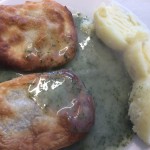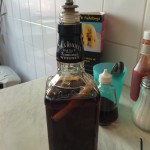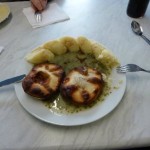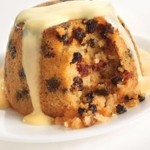Pay attention! Let’s start with a history lesson on that traditional east London delicacy, pie and mash, courtesy of the Maldon Pie & Mash shop website:
Pie and mash is a traditional London working-class food, originating from the East end of London.
Pie, mash and stewed eels shops have been in London since the 19th century, and are still common in south and east London, in many parts of Essex, and in places where there are significant expatriate British communities, including Australia where it is known as a pie floater.
During the Victorian era, due to the prevailing west to east wind, London developed in two ways: in the west and the centre, for the gentry and monified; in the east for the workers under the coal fire smoke cloud, also placing them closer to lands developed for industry and the London docks.
The working class were poor, and so looked for food stuffs which were cheap, in plentiful supply and easy to prepare. The savoury pie had long been a traditional way of preserving food, as well as in its smaller handsized form a transportable meal, protected safe from the surrounding dirt by its cold pastry crust.
European eels were one of the few forms of fish that could survive in the heavily polluted River Thames and London’s other rivers at this time, and so placed in pastry crust became a common workers meal. Supply was plentiful through to the late 1800s, particularly from the Dutch fishing boats landing catches at Billingsgate Fish Market. Adding cheap mashed potatoes made it a plate-based sit-down meal, and a sauce made of the water used to cook the eels, coloured and flavoured by parsley, made the whole dish something special.
If people had a bit of money in their pocket, then later mutton or cheap mince meat with no added onion could be alternatively ordered as the pie filling.
Post World War 2, as eel supply dwindled and as beef often became cheaper, and in far greater supply overseas, minced beef became the more popular pie filling. In recent years, the popularity of eel based pies climbed again, as the propensity of people to investigate their roots and origins climbed, and the associated customs and cultures. However, since 2010, it was revealed in a joint-study by Zoological Society of London and the Environment Agency that eel numbers in the River Thames had fallen from 1,500 in 2005 to just 50 in 2010, again leading to a reduction in eel-based pie orders based on commodity price alone.
Not many shops left (estimated 80 and falling), but those that are are venerated by aficionados, who travel many miles to enjoy a good plate of pie, mash, jellied eels and liquor. A friend belongs to a club that travels to these places just to enjoy the grub – and long may it last!
A word too on the composition of the meal, notably the liquor since this will rarely have been heard of outside the UK:
The main dish sold is pie and mash — a minced beef and cold water pastry pie served with mashed potato. There should be two types of pastry used, the bottom or base should be suet pastry and the top short. It is common for the mashed potato to be spread around one side of the plate and for a type of parsley sauce to be present. This is commonly called eel liquor sauce or simply liquor (although it is non-alcoholic), traditionally made using the water kept from the preparation of the stewed eels. However, many shops no longer use stewed eel water in their parsley liquor. The sauce traditionally has a green colour, from the parsley.[1] Sometimes a gravy is served instead (normally Oxo or Bisto).
Now I’ve had pie, mash and liquor on a number of occasions, but my boy had not. It seemed highly appropriate that he try great dishes like this at least once, so we tried to go to Maldon Pie & Mash some months back. Alas, this was an abortive trip since they had, unbelievably, run out of pies on that occasion.
This time I checked and was told there were plenty of pies in stock, so off we went. Sadly though there were no eels on the menu or I might have ordered a half portion with some vinegar (on the table in a JD bottle!) – just so Adam could try. It may not be a delicacy that appeals to everyone but it’s not half as fearsome as our kids might believe.
The shop itself pays homage to the traditional Victorian establishments, being white tiled and equipped with fairly basic benches and wooden chairs – but that is not what captures the attention. The walls of MP&M are lined with monochrome photographs depicting working class culture through the ages, interspersed with a few of British celebs and stars (Stones, Beatles, Kinks) enjoying a laugh, joke and, in the case of Ian Dury, a few cockles with a plastic fork from the carton. All these may well have popped into MP&M for some pie and mash, for all I know, but their presence makes for an evocative dining experience.
Drinks are fairly limited, mostly cans from the fridge or hot drinks from a machine, but what would East Londoners have drunk with their pie, eels and mash in times gone by? Maybe a good cuppa? At any rate, the grub was excellent once it arrived. The boy wimped out and went for instant gravy, but the liquor went quicker on my two pies and one mash, all for a reasonable £5.90.
The minced beef pie is home-made, tasty and topped with a gorgeous crust. Mash perhaps not exceptional but then it’s only the filler to go with the pies and liquor. It’s certainly not been supplemented by any poncey ingredients or shaped into a bizarre sculpture. Nope, just scraped around the edge of the plate as tradition dictates.
If that won’t do there are bangers or even (whisper it) veggie pies on sale, though not other flavours like Kate and Sidney, Chicken and Mushroom or what have you. Ah, but if you have a space to fill there are traditional puddings – spotted dick, jam sponge, treacle pudding, sticky toffee, all with custard (probably from a packet) or ice cream.
Not fancy or sophisticated but as historically British working class grub as you can buy – bearing in mind that most fish and chip shops now sell Chinese, kebabs, pizzas and goodness knows what else. Enjoy on its merits and enjoy a slice of cultural and gastronomic history while you can! Since most of the clientele during our visit were 60+, sometimes ++, there is a severe risk they might all die out unless we all take our offspring and encourage them to develop the taste.
















